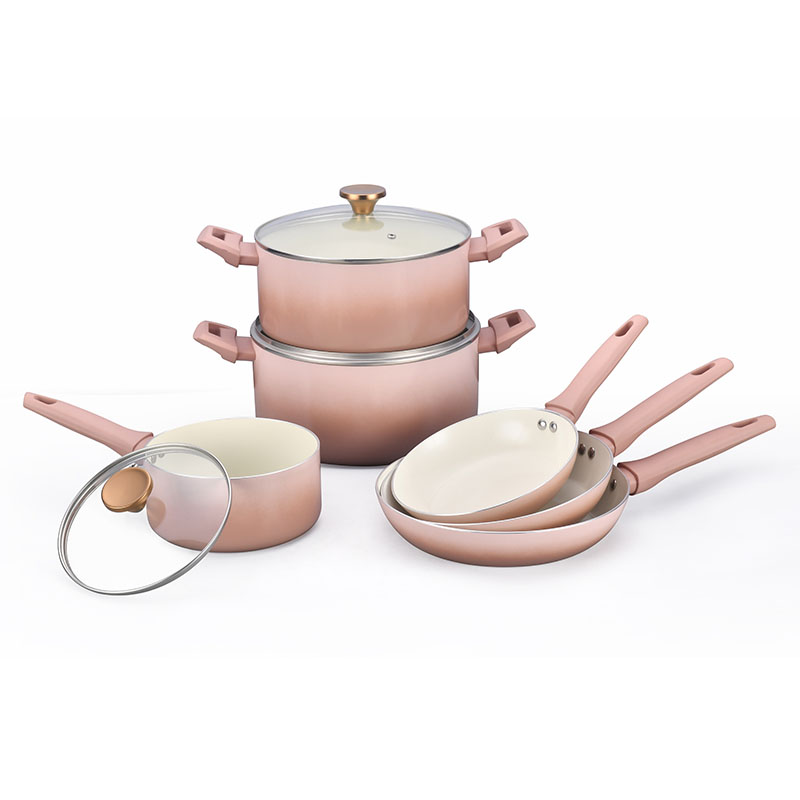Unlike traditional iron or cast iron pans, non-stick pans stand out with their unique "non-stick" properties. This property is mainly due to the special coating covering the surface of the non-stick pan. This coating material not only has good lubricity and a low friction coefficient, but also has a small surface tension, making it difficult for substances to adhere to the bottom of the pan, thus achieving the "non-stick" effect when cooking. In addition to achieving the non-stick effect, the non-stick coating also reduces oil smoke and oil consumption. So, what material is this magical non-stick coating made of?
The main materials of the non-stick pan coating
1. Polytetrafluoroethylene (PTFE)
The most common non-stick pan coating material is polytetrafluoroethylene, which is well-known as Teflon. It is a synthetic fluorinated plastic with extremely strong chemical stability and excellent non-stick properties. Teflon coating can not only effectively prevent food from sticking, but also withstand a certain degree of high temperature.
In recent years, as people's awareness of health and environmental protection has increased, ceramic non-stick pans have gradually become popular. Ceramic coating is an inorganic material made of silicon and water. It does not contain PFOA (perfluorooctanoic acid) and PTFE, so it is considered a safer and more environmentally friendly choice.
3. Diamond coating
Some high-end non-stick pan products use the so-called "diamond coating", which combines nano-scale diamond particles with materials such as Teflon to increase the hardness and durability of the coating, thereby enhancing the non-stick and wear resistance of the pan. Diamond-coated non-stick pans retain the easy-to-clean characteristics of traditional non-stick pans while having a longer service life.

However, in recent years, there have been endless controversies about non-stick pans. People are generally concerned that once the coating is scratched, will toxic substances be released? If these toxic substances are mixed with food and accidentally ingested, will they cause cancer? The heated discussion on the Internet has caused consumers in real life to have doubts about non-stick pans. Can such pans still be used safely?
Once the coating of a non-stick pan begins to peel off, it may indeed pose a certain potential risk to the human body, especially for Teflon coatings. Teflon can decompose at high temperatures, producing chemicals that are harmful to the human body. Although such temperatures are difficult to reach under normal cooking conditions, if the coating begins to fall off, these chemicals may enter the food in the form of tiny particles.
On the other hand, even if trace amounts of coating particles enter the food, the direct impact on human health is generally considered to be limited, because PTFE itself is considered inert and not easily absorbed by the body. However, long-term ingestion or contact is considered to be potentially risky.
In addition, if the coating in the non-stick pan contains perfluorooctanoate (PFOA), which was commonly used in the past, the concern will be higher. PFOA has been shown in studies to have potential negative effects on human health, including affecting reproduction and development, increasing the risk of certain types of cancer, etc.
All Telamon cookware is 100% PFOA-free. We use high-quality non-stick coatings that do not contain harmful chemicals such as PFOA to ensure safe and healthy cooking for you and your customers. At Telamon, we are committed to combining performance, durability and safety in every product.
Precautions
1. Do not use hard objects such as metal utensils to scratch the coating during use to avoid scratching the coating surface, which will affect the service life.
2. Do not use the pan in a dry pan. Empty cooking without adding ingredients can easily cause the coating to overheat and cause damage.
3. When cleaning, do not use rough detergents, hard brushes or metal utensils for cleaning. Only soft utensils and soft detergents can be used for cleaning, and the surface must not be scratched.
Once the coating of the non-stick pan begins to peel off, the safest thing to do is to stop using it and replace the pan. It is also recommended to use high-quality pans and strictly follow the manufacturer's use and care guidelines to maintain them to extend the life of the pan and ensure food safety.



 Español
Español عربى
عربى

